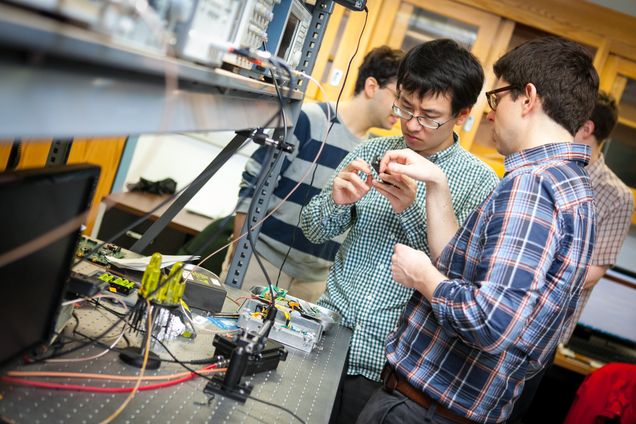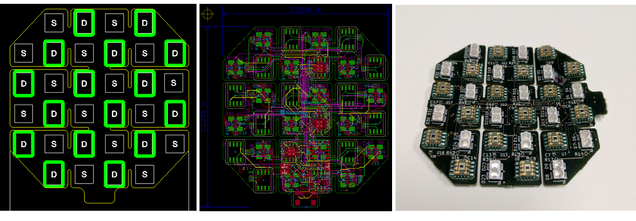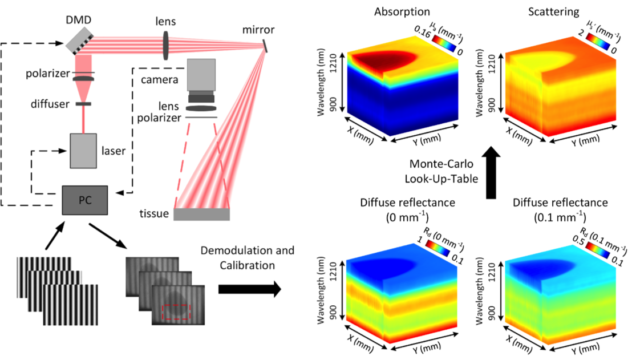
BOTLab Research Projects
Our group is developing a suite of optical technologies to study tissue structure and function. We specialize in the development diffuse optical technologies to study cancer and cardiovascular disease. Below is a summary of our current research projects.
Wearable Oximetry for Breast Cancer Treatment Monitoring
We are developing a near-infrared (NIR) wearable probe to monitor breast tumor hemodynamics during the course of neoadjuvant (presurgical) chemotherapy. The probe has a hybrid flex-rigid design that conforms to the natural breast shape and a high-density optode array that provides spatial mapping of oxygenation change in a 3D fashion. We are collaborating with Naomi Ko, MD at the Boston Medical Center (BMC) to validate the wearable probe in breast cancer patients.
Funder: American Cancer Society

The figure above shows a new wearable probe we are currently testing for continuous motoring of breast cancer patients.
Real-Time Frequency Domain Diffuse Optical Spectroscopy (FD-DOS) for Breast Cancer Imaging
We are developing an optical technology called digital FD-DOS that can be used to rapidly scan over tissue to map spatial variations in parameters such as oxygen saturation, total hemoglobin, oxyhemoglobin, and deoxyhemoglobin concentrations. We are developing this technology for tracking breast tumors while patients are treated with chemotherapy.
Funder: Department of Defense
Short-Wave Infrared Spatial Frequency Domain Imaging (SWIR-SFDI) of in vivo Blood Lipids
There has been a recent interest in exploring the shortwave infrared (SWIR) spectral region (approximately 900 nm – 2000 nm) due to development of newly available SWIR detectors and the reduced optical scattering at these longer wavelengths, allowing for deeper optical penetration in biological tissue. We are developing quantitative SWIR-SFDI to quantify the level of lipids and other macronutrients in blood. This could lead to a new non-invasive way to track blood lipids continuously throughout the day. This would provide a new means to assess cardiovascular health without blood draws.
Funder: National Institutes of Health

The figure above shows how spatially modulated illumination combined with model-based analysis can be used to extract quantitative optical properties in the shortwave infrared wavelength band. This information can be used to better quantify blood content, metabolic state, and the concentration of water, fat, and collagen in tissue.
Frequency Domain Diffuse Optical Spectroscopy (FD-DOS) and Diffuse Correlation Spectroscopy (DCS) for Monitoring Patients during Mechanical Ventilation
We are combining FD-DOS with DCS to non-invasively quantify the metabolism of inspiratory muscles such as the steronomastoid. We are developing these techniques to monitor patients under mechanical ventilation in the intensive care unit. In the future, this may allow for better clinical management and outcomes for these patients.
Funder: National Institutes of Health
Spatial Frequency Domain Imaging (SFDI) for Preclinical Tumor Imaging
We are developing SFDI to track treatment response and resistance in preclinical models of cancer. SFDI is a widefield imaging modality that provides quantitative measurements of tissue chromophores including oxyhemoglobin and deoxyhemoglobin. This allows us to non-invasively monitor tumor hypoxia, blood volume, and tissue oxygenation in a label-free manner. One of our long-term research goals is to improve the efficacy of chemotherapeutic agents by using optical techniques to help explore and validate novel drug combinations and schedulings.
If you are interested in making your own SFDI system, check out our openSFDI project.
Funder: Department of Defense; National Science Foundation
Multiphoton Imaging for Cancer Metabolic Imaging
We are developing multiphoton microscopy for imaging applications in cancer. For example, we are using Fluorescence Lifetime Imaging (FLIM) for monitoring tumor cell metabolism during invasion.
Funder: National Science Foundation